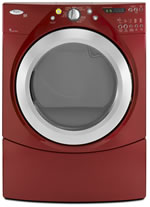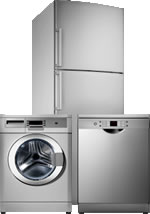Proper Venting for a Clothes Dryer
 |
Whether you have an electric or gas dryer, the heated air must be vented to the outdoors. If you have a gas dryer, the venting is especially critical because it carries the toxic combustion gases. There are a few models that do not require venting, always electric, but they have the disadvantage of dumping the waste ehat into the room, increasing the room temperature. Also, the moisture must be piped to a drain or accumulates in a tank that must be emptied.
The vent also carries warm, moist air, which if not properly vented to the outdoors, can lead to mold, mildew, excessive indoor humidity and other problems. Also, because dryer lint can build up in the vent, an improperly maintained dryer vent is also a serious fire hazard.
A gas dryer burns a mixture of natural gas or propane and air. The resulting combustion gases of carbon monoxide and dioxide are created. These gases must be properly vented to the outdoors to prevent asphyxiation or poisoning.
A typical vent hose is about four inches in diameter. It can be made of rigid steel or aluminum, semi-rigid aluminum, flexible foil or flexible PVC / vinyl. The vent hose connects from the rear lip of the dryer to the lip of an exterior vent and should be held in place on both ends with a band clamp.
The safest choice for a vent hose is a rigid metal. There are two reasons for this, first, the rigid metal eliminates the sagging that occurs in flexible venting. Sags allow lint to accumulate in the vent and represent a fire hazard. Second, the metal is not flammable and helps contain a fire if the lint does ignite. The down side to the rigid vent is that it is more difficult to connect to the dryer because it is not flexible. Because it is not flexible, you must have access to the back of the dryer to connect the vent line in place.
A reasonable alternative is a semi-rigid aluminum vent. This material is fairly fire resistant and less prone to sagging. Because it is flexible, you can connect it to the dryer before moving the dryer into place.
The foil coated and plain PVC / vinyl vent hoses are NOT recommended. These hoses are not fire resistant and are prone to sagging. Lint build up is a problem and if the lint catches fire, the vent hose burns too.
In all cases, the venting you use should be of the shortest length possible and should be arranged so that no low points (in which lint can accumulate) exist between the dryer and the exterior vent. Use as few turns as possible and avoid sharp turns when possible. Each turn increases friction and reduces airflow which increases the risk of lint build-up.
The exterior vent should have a self closing door to prevent both drafts and to keep out rodents.





